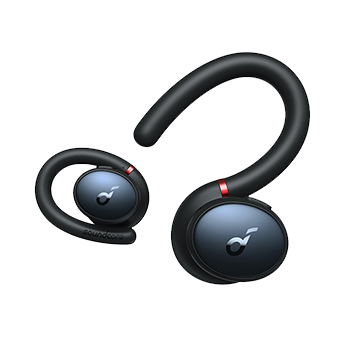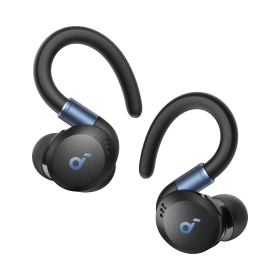Different Types of Headphones: A Comprehensive Guide
Headphones and earbuds have become ubiquitous in our daily lives, serving both casual listeners and discerning audiophiles. Are you in the market for a new pair of headphones? Whether you need everyday wired earbuds or noise-canceling headphones for travel, understanding the different types of headphones and their features is essential. In this blog post, we'll get deep into the world of headphones, exploring popular styles like closed-back headphones, on-ear/over-ear headphones, noise-canceling headphones, etc. After looking through them, you will know which type of headphones are good for ears. Based on their different features, we divide them into four classifications. Read on to explore more!
Design and Acoustics
Closed-Back Headphones
Closed-back headphones are designed with sealed ear cups that offer excellent noise isolation. They keep external sounds out while containing the audio within, providing a more intimate listening experience. Ideal for studio monitoring, these headphones are favored by audio professionals and enthusiasts alike.

Open-Back Headphones
Open-back headphones, in contrast, have perforated ear cups that allow air and sound to pass through. This unique design contributes to a spacious and natural soundstage, which is often sought after by audiophiles for its accurate audio reproduction. Beyond just delivering superior sound quality, the open structure ensures breathability, enhancing comfort during extended listening sessions and reducing ear discomfort. Among the standout models in this category are the Sennheiser HD650 and Sony LinkBuds.
Fit and Form Factor
Open-Ear Headphones
Open-ear headphones are designed to fully free your ears while isolating external noise. Open-ear headphones function by passing sound vibrations through the air or your cheekbones. You can hear music without anything covering or pressing on your ears since the sound waves are directed directly to your middle ear, avoiding your eardrum.
They make it possible for you to immerse yourself in the music while remaining aware of your surroundings. The enhanced safety feature of open-ear headphones, like soundcore Aerofit open-ear earbuds, suits perfectly for those who run or walk outdoors and listen to music without worrying about their surroundings or getting into an accident.

On-Ear Headphones
On-ear headphones rest on the ears rather than enclosing them. They strike a balance between portability and comfort, offering good sound quality without fully sealing off the ears from the environment. They are also lighter than over ear headphones, alleviating the stress on the headband positioned atop your head. Investing in a higher-priced on-ear model can be a wise choice, as it often translates to superior performance in areas that matter most to users, such as sound quality and comfort.
Over-Ear Headphones
Over ear headphones envelop the ears completely, providing excellent noise isolation and immersive sound. Exhibiting remarkable prowess in noise containment, these headphones excel at preserving your auditory experience while permitting ambient sounds to disperse. Notably, open-backed over-ear headphones even facilitate a sonic exchange with the environment, enhancing both breathability and acoustic interplay.
A recommended product in this category is the soundcore Space Q45 headphone, known for their impressive audio quality and comfortable design.

In-Ear Earbuds
Earbuds are small, lightweight headphones that fit directly into the ear canal. They are highly portable and convenient for daily use, making them a popular choice for those on the go. Moreover, Earbuds, like in-ear headphones, are easily transportable and very compact, but due to the small size of the speaker, they struggle to create true sound isolation. Depending on the model, some higher quality models may include advanced technology to help with even more quality and accuracy, but the main advantage of earbuds is their small size.
In-Ear Headphones
In-ear headphones, also known as in-ear monitors (IEMs), fit snugly into the ear canal, providing excellent noise isolation and sound quality. They are popular among musicians and audiophiles. Unlike earbuds that that sit on the outer rim of your ears, these go deeper into your canal to rest inside your ears and get somewhat closer to those valuable ear drums.
This offers numerous benefits, encompassing comfort, noise isolation, and audio precision. Think of them as the closed-back version of on-the-go headphones. This design minimizes sound leakage, ensuring that sound remains in your ears while blocking out external noises effectively.
Clip-on Headphones
Clip-on headphones feature clips that attach to the ears, rather than traditional headbands. They are lightweight and convenient for physical activities while delivering decent sound quality. Clip-on headphones share a resemblance with traditional earbuds featuring ear hooks, exemplified by the Bose Sport Open Earbuds. However, they distinguish themselves by incorporating larger drivers, typically ranging from 13mm to 30mm, which sets them apart from standard earbuds with smaller drivers measuring between 8mm and 15mm. There are even varieties that can be attached to motorcycle helmets with adhesive or velcro strips.
Connectivity
Bluetooth Headphones
Bluetooth headphones offer wireless connectivity, allowing you to enjoy audio without being tethered to your device. They come in various styles, from over-ear to in-ear, offering the flexibility of movement. Furthermore, the sound quality of Bluetooth headphones is comparable to that of corded headphone models - you do not lose any sound quality simply because the cord is lost. There are many types of Bluetooth headphones, including Sony WH-1000XM4 Wireless.
Wired Headphones
Wired headphones maintain a direct connection to the audio source, ensuring consistent audio quality without concerns about battery life or wireless connectivity. The most common configuration is two wires connecting both speaker drivers and terminating in a single 3.5mm plug. The plug is then inserted into a 3.5mm jack on an audio source (a PC, laptop, or mobile device).
Some of the Sample wired headphones that you can check out in the market are the Beats EP Wired On-Ear Headphones and Skullcandy Ink’d+ Wired Earbuds.
Wireless Headphones
Wireless headphones, often utilizing Bluetooth technology, offer the freedom of movement without the tangle of wires. They are available in various styles to suit different preferences. Wireless headphones and earbuds use radio frequency (RF), infrared (IF), or Bluetooth to connect to audio sources. As a result, they lack the standard headphone plug found in wired headphones. This is not to say that wireless headphones are free of wires. Wireless earbuds, such as the Beats Flex, still have a wire connecting the two earbuds.
If you are looking for types of wireless headphones, the top two devices in this category that you can check are the soundcore Life Q20 and Elgin Ruckus Discord Bluetooth Earbuds.
Feature-Based
Noise-Cancelling Headphones
Noise-cancelling headphones use technology to actively reduce external sounds, providing a serene listening environment. Furthermore, most noise cancelling headphones use soundproofing, which keeps out many of the higher frequencies, or either of the two methods for higher frequency sounds. The soundcore Q20i headphone is a recommended choice, offering both noise cancellation and impressive audio performance. Plus, you can also go for another best which is the soundcore Life Q30 headphone.
Frequently Asked Questions
Are In-Ear or Over-Ear Headphones Better?
The choice between in-ear and over-ear headphones depends on your preferences and use cases. In-ear headphones provide excellent noise isolation and portability, while over-ear headphones offer immersive sound and comfort for extended listening sessions.
What Are the Different Types of Noise-Canceling Headphones?
Noise-canceling headphones come in two main types: passive and active. Passive noise isolation relies on the headphones' physical design to block out sounds. In contrast, active noise-canceling headphones employ advanced electronics to detect external sounds and then produce opposing sound waves that effectively cancel out those noises.
Which Type of Headphones Are Good for Ears?
Over-ear headphones are generally better for the ears compared to in-ear earphones. This is because over-ear headphones, especially those equipped with effective passive noise isolation or active noise canceling, excel at blocking out external noise. As a result, users can listen to their audio at lower volumes, reducing the risk of potential ear damage.
Conclusion
All in all, there are many types of headphones out there depending on what your needs and wants are. From wireless to noise-canceling, closed-back to open-back, Bluetooth to wired - headphones come in many shapes and sizes. It’s important for you to make an educated decision when purchasing a pair of headphones as it is an investment that will hopefully last you some time. We hope this blog post has helped shed light on the various types of headphones available, so that you can purchase the most suitable pair for your lifestyle accordingly. Now that you know the difference between all these different types of headphones it’s time to get yourself a pair and experience customised comfort and sound like never before!





























































